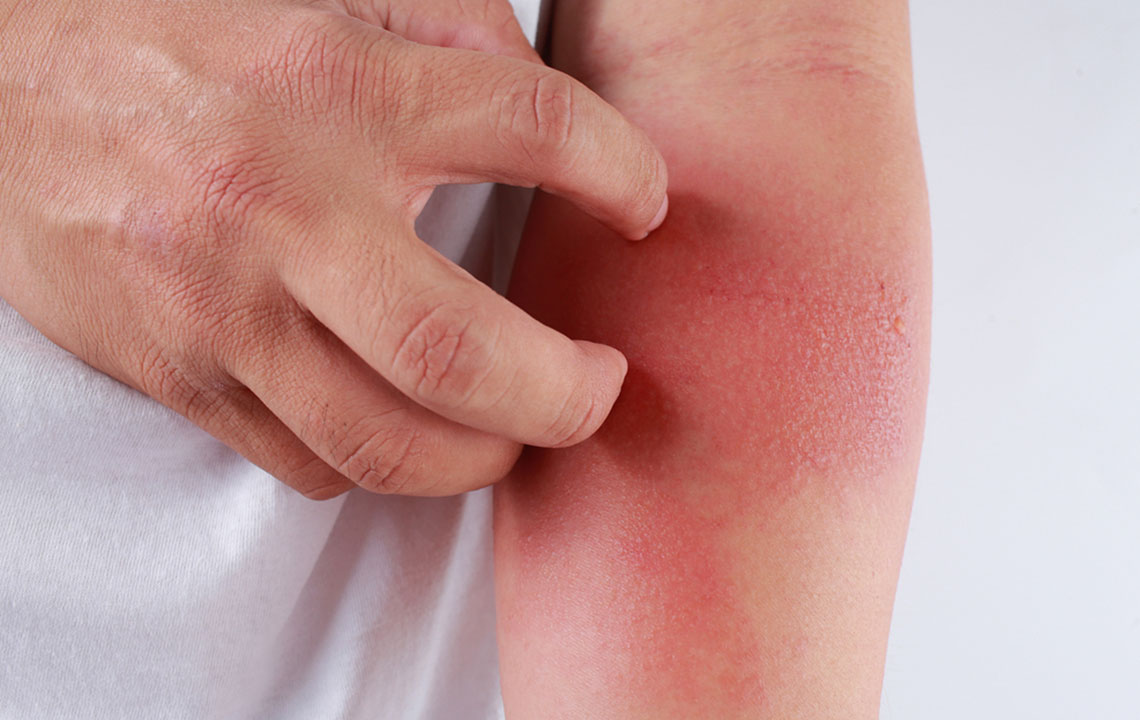Here’s How to Identify a Skin Rash

Skin rashes can be uncomfortable, unsightly, and downright embarrassing. A skin rash might affect you for multiple reasons and knowing the cause or trigger for your skin rash will go a long way in treating and preventing their occurrence.
A rash can be identified based on the appearance of the skin affected. The skin could be red, have bumps, become scaly and itchy. Moreover, there are a host of other ways to identify a skin rash. Make sure to take note of all the symptoms and the appearance of the rash.
You can get a rash due to a multitude of reasons. The main reasons for rashes include:
- Allergens
- Medications
- Cosmetics
- Certain diseases
Allergic contact dermatitis
This condition covers any rash that occurs when the skin comes into physical contact with an allergen. Knowing what you are allergic to is imperative as you can then take care to avoid it. Sometimes, you can be allergic to multiple things. Taking an allergy test is the best way to tackle this type of rash.
In case you still do not know the cause of your allergy, it is best you do not touch the rash. Use warm water and a mild soap over it. In most cases, the allergen sticking to your skin will wash away with this step. If the rash persists, you can use a hydrocortisone cream over the rash.
If your rash is accompanied by blisters, then a cold compress can do wonders to relieve the pain. Use this compress three times a day until the blisters disappear.
Drug rashes
Drug rashes are any rashes that are caused due to the body’s reaction to certain medication. Drug rashes vary from being mild to life-threatening. Drug rashes can appear instantaneously or can even appear weeks later.
There are three types of drug rashes:
- Rashes caused due to an allergy to a medicine.
- Rashes that are a direct side effect of the medication.
- Rashes caused by sensitivity to the sunlight due to the medication.
Since there are different types, here is how you can identify a drug rash.
- Acne is patches of pimples accompanied by redness. It usually occurs on the face, shoulders, and chest area. It could be an allergic reaction to medicines like anabolic steroids, corticosteroids, iodides, and bromides.
- The appearance of red hives is raised bumps. They are caused by a reaction to penicillin, some medical dyes, and aspirin.
- Purpuric eruptions are purple areas on the skin, usually found in the legs. This type of rash occurs due to some anticoagulants and diuretics.
Makeup rashes
Any beauty product from shampoos to eyeshadows to perfumes can cause skin allergies. These allergies are usually dry, itchy, and are accompanied by redness and hives. The rashes caused by cosmetics are of two types-one where the product irritates the skin, and the other is where the immune system itself gets compromised due to certain ingredients in the products.
Make sure that you use products that do not have too many ingredients. The lesser the ingredients, the lesser the chance that your skin will react to the product. Once you buy the product, do take a patch test. Apply a small amount of the product on your skin and check that patch for any reaction up to 48 to 72 hours later.
When using perfumes, make sure you spray it on your clothes and not directly on your skin. The fragrance might cause a reaction with any other products you might have used. Make sure you talk to your dermatologist about your skin rashes.
Reactions to cosmetic products can include:
- Contact urticaria is itching, tingling or burning sensation in the area in which the cosmetic is applied. It can also be accompanied by swelling and redness. It occurs within an hour of application and resolves itself within 24 hours.
- Anaphylaxis is linked to common ingredients in hair dyes. It is identified with vomiting, nausea, difficulty in breathing, and rash with swelling. This type of reaction could be fatal.
- Photocontact dermatitis is a rash that occurs when one of the ingredients in the cosmetic product reacts in the presence of sunlight. Hence, it is important to identify these ingredients beforehand and avoid them.
Home remedies for mild skin rashes
There are many ways in which you can calm down a rash with simple ingredients present in your home. Here are a few remedies that you can try.
- Use warm water instead of hot water while taking a bath.
- Use a mild soap with few ingredients.
- Use a soft towel to pat the rash dry. Never rub the rash as it can cause further irritation.
- Do not cover the rash as it will fare better if allowed to air out.
- Do not scratch the rash as that could cause an infection.
- Stop using any new cosmetic product you might have used recently.
- Use a mild, unscented moisturizer on the rash to soothe the irritation.
- Make sure you use an anti-dandruff shampoo since dandruff can worsen skin rashes.
Make sure that you consult with a doctor if the symptoms of your rash do not go away once you have tried these remedies. Skin rashes are best treated when addressed early.


